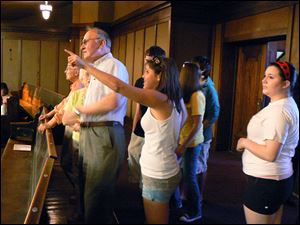
Preserving Jewish history
5/2/2009
Wesley Flaum points to some of the Jewish symbols still visible inside the former Temple B nai Israel at 12th and Bancroft streets, now the True Church of God of the Apostolic Faith.
There's never been a better time than today to teach local Jewish teenagers about their religious and cultural heritage, according to Veronica Burgert.
"Jewish Toledo isn't getting any bigger. It's very important to keep the history alive and to hear all the stories," said Ms. Burgert, who teaches Jewish Sunday school classes.
Last Sunday, two Jewish seniors led a group of 15 teenagers on a bus tour of Toledo to visit some historic Jewish sites.
The week before, the same students attended a class in which Jewish seniors talked about growing up in Toledo in the 1930s and '40s.
As part of the focus on community history, the United Jewish Council of Greater Toledo also commissioned the publication of a new book, A History of the Toledo Jewish Community 1895-2006: A Rich Tapestry of Historical Information.
The book, written by local historian David Noel, was printed in newspaper format and will be soon published in book form.
Efforts to remember historic Jewish Toledo come during a period of shrinking population. A 1973 survey found that there were 7,250 Jews in the Toledo area; in 2000 that number had dropped to 5,461.
Pollster Stan Odesky, 71, who led one of the bus tours, said the number of Toledo area Jews is closer to 4,000 today.
"We need to pass on our heritage," he said.
Marvin Jacobs, a 79-year-old Toledo lawyer who led the other tour group, echoed that remark.
"We wanted them to know what things were like years ago," Mr. Jacobs said.
The decline of the Jewish population, both in Toledo and nationwide, has been attributed to an aging population, low fertility rates, a drop in the number of Jewish immigrants, and an increasing number of Jews who marry non-Jews and don't raise their children to practice Judaism.
The two-hour tour started from The Temple-Congregation Shomer Emunim, at the heart of today's Jewish community. The Reform Jewish congregation shares a campus with the Jewish Community Center, the United Jewish Council of Greater Toledo, and the Conservative Jewish congregation B'nai Israel.
The buses headed east to downtown Toledo, where the Jewish community once was centered.
Temple B'nai Israel, for example, a spacious brick-and-stone edifice, was built at 12th and Bancroft streets in 1914. The main floor had seating for 700 and the balcony accommodated 300. Originally an Orthodox congregation, women used to sit upstairs, according to Mr. Jacobs.
An annex built in 1924 housed the community's Hebrew school. Weddings were held on the second floor and dances on the third floor, Mr. Jacobs said.
The former temple now is home to the True Church of God of the Apostolic Faith. The Jewish tour group arrived shortly before the True Church of God's Sunday morning service and was invited to look inside.
Many of the Jewish symbols are still visible, including a Jewish Star of David set in the interior dome, which reaches a height of 50 feet. The original stained-glass windows retain their Hebrew writings and Jewish symbols, including menorahs, or candelabras, and Torahs, or Hebrew Bibles.
"Look how beautiful it is," said Wesley Flaum, 15, a ninth-grader at Maumee Valley Country Day School.
Her grandparents owned Flaum's Market, one of many businesses that once were part of a thriving Jewish neighborhood centered at Canton and Woodruff avenues.
Miss Flaum and her friend, Sarah Myers, 16, a Southview High sophomore, said they did a class project in sixth grade on Toledo Jewish history and the tour helped bring those stories to life.
The Canton-Woodruff area had been lined with kosher delis, markets, grocery stores, butcher shops, bakeries, dry cleaners, ice cream parlors, and other stores and businesses catering to their Jewish neighbors.
Only a few buildings from that era remain; most were razed decades ago during urban renewal.
The downtown area had been home to other synagogues including Congregation B'nai Jacob on 12th Street, Congregation Anshai Sfard at Canton and Scott streets, and Sharie Zedeck at 2102 Mulberry St. Sharie Zedeck is now the Eastern Star Baptist , but the wrought-iron fence still features two large Stars of David.
"Few people had automobiles then, so there was little or no parking at the temples. Most people walked," Mr. Jacobs said.
The Jewish community migrated a few miles west to the Old West End, where Congregation Shomer Emunim built a new temple on Collingwood Boulevard. The spacious building is now the home of Bibleway Temple, a Pentecostal Christian church.
As automobiles gained popularity and individual mobility increased, the Toledo Jewish community migrated further west. B'nai Israel moved to Kenwood Boulevard and Orthodox congregation Etz Chayim built a synagogue on Woodley Road.
The migration continued westward to Sylvania, about a dozen miles from downtown, starting when Shomer Emunim broke ground on a new temple in 1973. The JCC moved in a few years later and B'nai Israel dedicated its new temple on the same grounds in 2007.
"The tour was interesting," Max Liber, 15, said. "I enjoyed it and a lot of the buildings still look pretty new."
Contact David Yonke at:
dyonke@theblade.com or
419-724-6154.